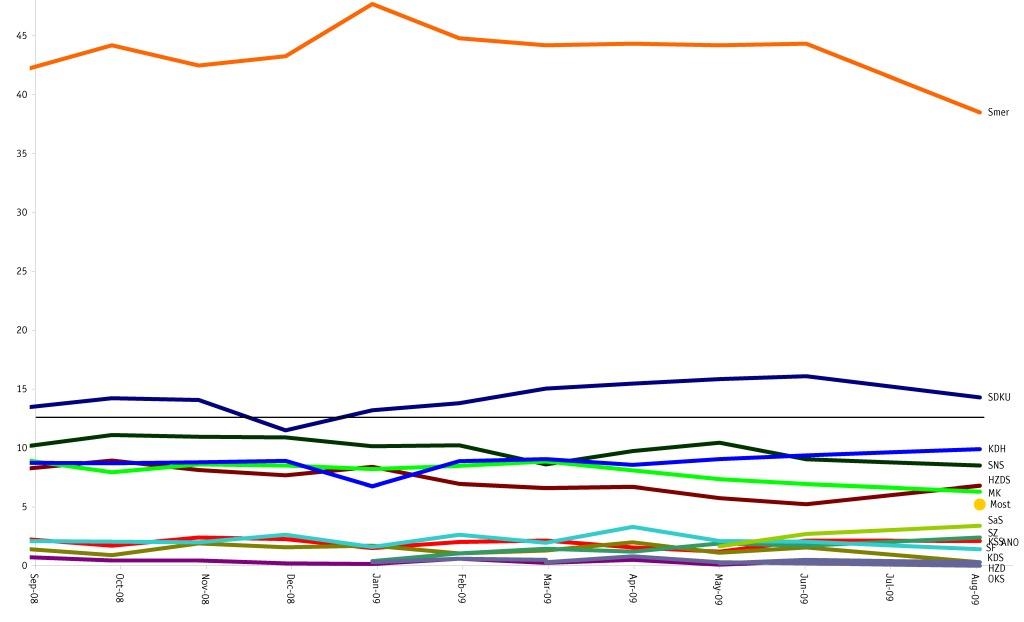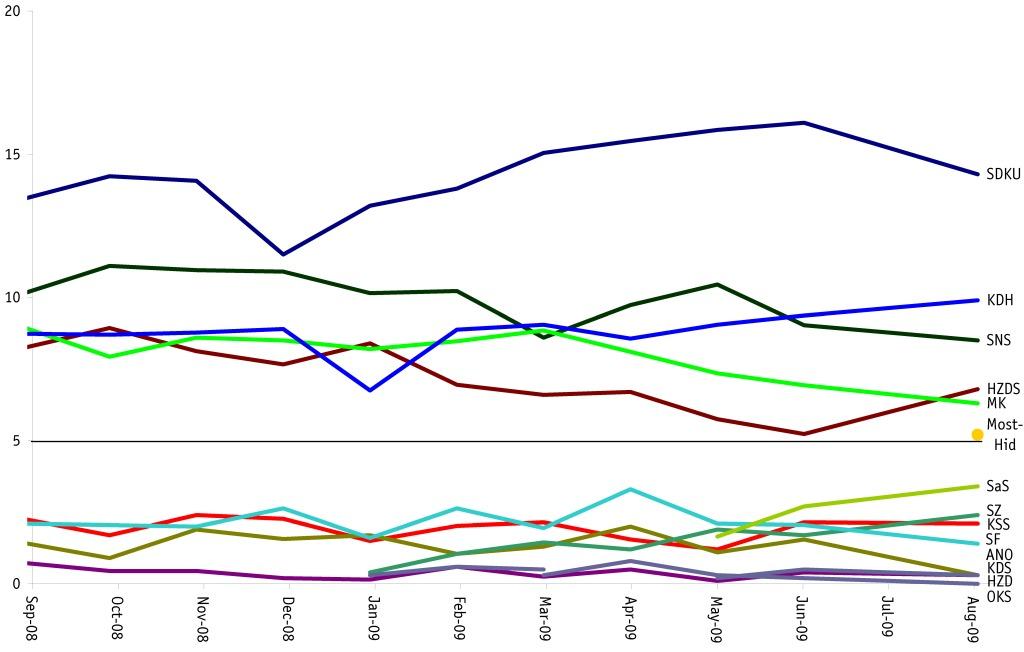This post comes a bit late because of changes to the pozorblog site but the month’s news is important enough to warrant an interim post.
Things only changed a little this month. But small changes from one month to the next add up. And this month not all the changes are small. A few areas to watch.
Smer

As the image shows Smer remains far above its nearest competitors–still well over double the preferences of SDKU. But the last four months have seen a drop in Smer preferences from the mid-40s to the high-30s. This shift is primarily in FOCUS polls, however, and it is difficult to say whether the result is “real” or some sort of blip. Median, the only monthly alternative, shows no similar drop. I am really missing UVVM this month as it was always helpful to see what a second pollster said before making a judgment, and MVK polls are as unpredictable–in their appearance, not their results–as weather.
 Closer look at Smer polls over time show a gradual increase over the last two years peaking in a cluster in late 2008 and then reverting back to the previous plateau and now, again to a lower level, though whether that lower level is part of a plateau or a slope is something we will have to see about. I suspect next month will show Smer higher in Focus polls but lower than its average level for the last 5 months. I suspect this month’s drop is a bit of an outlier, just as its previous peaks did not always sustain themselves and appear to be noise rather than signal.Smer doesn’t have too much to fear–it’s still hard to calculate a way that it won’t be in the next government, but it wouldn’t surprise me if some mid-level Smer types were starting to work on their political insurance policies.
Closer look at Smer polls over time show a gradual increase over the last two years peaking in a cluster in late 2008 and then reverting back to the previous plateau and now, again to a lower level, though whether that lower level is part of a plateau or a slope is something we will have to see about. I suspect next month will show Smer higher in Focus polls but lower than its average level for the last 5 months. I suspect this month’s drop is a bit of an outlier, just as its previous peaks did not always sustain themselves and appear to be noise rather than signal.Smer doesn’t have too much to fear–it’s still hard to calculate a way that it won’t be in the next government, but it wouldn’t surprise me if some mid-level Smer types were starting to work on their political insurance policies.
SDKU and KDH:
 Take Smer out of the graph and it looks more like a competitive party system. And this fall for the first time in a long time, the two top competitors to Smer are both from the opposition: SDKU and KDH. SDKU dropped slightly this month in FOCUS polls but it’s still near a historic high (in the past it would do this well in elections but not in polls). Some of its slight decline may relate to the rapid resurgence of KDH, a party that has taken a sudden upward jump due, I must think, to the energizing presence of Jan Figel, former European Commissioner. I am interested to see whether Figel’s more proactive approach will keep the party preferences high. In some sense, this does not help the opposition much, since those attracted to Figel are probably those who would otherwise hold their noses and vote for SDKU, but since they might also vote for SaS, it keeps votes among the larger opposition parties. Thumbnails for SDKU and KDH are here:
Take Smer out of the graph and it looks more like a competitive party system. And this fall for the first time in a long time, the two top competitors to Smer are both from the opposition: SDKU and KDH. SDKU dropped slightly this month in FOCUS polls but it’s still near a historic high (in the past it would do this well in elections but not in polls). Some of its slight decline may relate to the rapid resurgence of KDH, a party that has taken a sudden upward jump due, I must think, to the energizing presence of Jan Figel, former European Commissioner. I am interested to see whether Figel’s more proactive approach will keep the party preferences high. In some sense, this does not help the opposition much, since those attracted to Figel are probably those who would otherwise hold their noses and vote for SDKU, but since they might also vote for SaS, it keeps votes among the larger opposition parties. Thumbnails for SDKU and KDH are here:
SDKU——————————————————– KDH


HZDS and SNS:
Slovakia’s two minor governmental parties continue their respective slow slides, partly the result of Smer’s remarkable skill at picking off their voters and partly the result of their own internal struggles and disadvantages. HZDS has stopped falling for the moment but given the party’s steady 10 year slide and absence of anything new that might recommend it, it is hard to imagine anything but continued decline (with the key question: 5% or not 5% next June). SNS’s decline has been disquised at times by the party’s erratic support shifts but it is notable that all of the trendlines (24-month, 12-month, 6-month and 3-month point down at almost the exact same angle). The party has more leeway for falling than HZDS but it is not immune, and at some point SNS mid-level leaders are going to need to decide what to do if they feel that Jan Slota is pulling them down. The party’s structures are so focused around the party chair that the only way to force change will be to leave, but the last time they did that the parties split the electorate 50/50 and neither got into parliament.
SNS——————————————————– HZDS


SMK and Most-Hid
Not much to say here, yet. For two polls in a row both parties are poised to make it into parliament. If this can continue then Bela Bugar has done a big favor to the Hungarian electorate, bringing back those disenfranchised from SMK. If both don’t stay above 5 and neither drops to near-zero, then the Hungarians will see their poorest electoral showing since the early days of Slovakia’s democracy. I’d be keen to hear any thoughts from Magyarophones about what to expect here as this is a subset of the population from which I hear little direct news.
SMK (regular graphs for Most-Hid coming soon)

Smaller Parties:
Not much news here this month. SaS shows staying power at around 3%, and KSS recovered this month to its traditional 3% levels as well (though it has not been there for awhile). Below, around 2% stands SF (recovering slightly from a major drop the previous month) and at at the flatline level are OKS, KDS, ANO and Liga (which didn’t get a single person to mention it’s name this month even though it’s on the list). Between them are two more: HZD (slightly higher than expected–it’s been flatlining) and the Greens (somewhat lower than expected–last month it even beat KSS).
What it all means? The Coalition Partner Game
It’s still Smer’s ballgame, but coalition politics could become extremely interesting if Smer does end up at around 35% and HZDS or SNS fall below 5%. It is dangerous to trust what parties say about potential coalition partners, but as of now, SDKU and KDH appear to have ruled out coalition with Smer (Dzurinda is right, I think, to note that such a coalition would severely hurt his party, and he doesn’t have the organization or track record to ride it out the way ODS and CSSD did with their opposition agreement in the Czech Republic). But if this option truly is gone, then there are few other combinations that can make 50%. If the existing coalition can’t muster 50% because one party drops off, then Fico would need to find alternatives, but (even though I generally do not rule things out) there will be no coalition containing both SNS and either SMK or Most-Hid, and SaS, the only other party that looks now to have a chance, has promised up one side and down the other that it will not join forces with Smer. So Smer’s only real chance is probably SNS+HZDS or so many votes for parties that fall below the threshold that it can with SNS or HZDS form a bare majority government.
At the same time, there’s not much hope for a government of the current opposition parties. Even with SDKU and KDH and SMK and Most-Hid and SaS, there’s nothing like a majority. It might be possible to create one by adding HZDS to this but even that’s unlikely and HZDS is the party in greatest danger of falling short. In 10 short years, HZDS has gone from a huge and polarizing force in Slovakia’s politics to a tiny but necessary coalition partners. The more things stay the same, the more they change.
 Everything you never wanted to know about politics in Slovakia and were therefore afraid to ask (lest I’d tell you). I’ve finally had a chance to annotate an absurdly long and detailed presentation on Slovakia’s politics which derived in large part from the exercises I’ve been conducting on this blog (and past efforts). The questions, some of which are rigorously answered in this presentation (and others of which I speed through hoping you’ll take my word for it):
Everything you never wanted to know about politics in Slovakia and were therefore afraid to ask (lest I’d tell you). I’ve finally had a chance to annotate an absurdly long and detailed presentation on Slovakia’s politics which derived in large part from the exercises I’ve been conducting on this blog (and past efforts). The questions, some of which are rigorously answered in this presentation (and others of which I speed through hoping you’ll take my word for it):















 I know Slovakia’s journalists are overtaxed with all that is required of them, but there are things they could do to make things better without too much extra work. Case in point: today all major Slovak news sources today report, almost word for word, a press release from the firm Median reporting poll results from July:
I know Slovakia’s journalists are overtaxed with all that is required of them, but there are things they could do to make things better without too much extra work. Case in point: today all major Slovak news sources today report, almost word for word, a press release from the firm Median reporting poll results from July:

